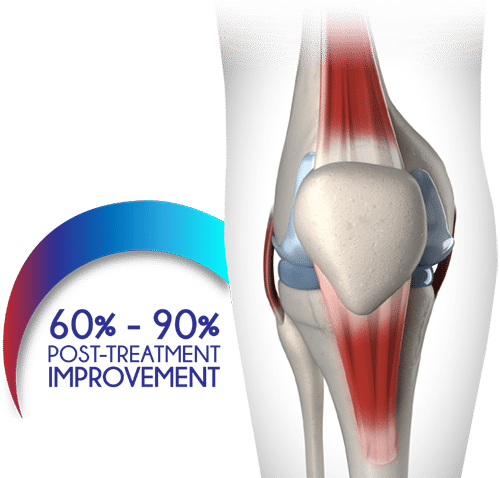KNEE PAIN
Tendonitis
What is it and how do we treat it?
Healthy Knee
The patella is the kneecap, and the patellar tendon extends from the kneecap to the top of the shinbone (tibia). The tendon is extremely short, but it’s wide. The patellar tendon allows the quadriceps to create a strong force at the knee, providing a mechanical advantage to the knee. This tendon is essential for running, jumping, kicking, and other such activities.
Knee Tendonitis
Patellar tendinitis is an injury that affects your knees when you overuse the patella tendon. This condition is also known as patellar tendinopathy or a jumper’s knee because it’s particularly common amongst athletes. Patellar tendinitis is one of the few running and jumping-based knee pain conditions more common amongst men rather than women.
Call us or submit this form make a vein treatment appointment
Your information is encrypted and secure. By registering you confirm that you accept Terms and Conditions and Privacy Policy
The symptoms of patellar tendinitis can resolve themselves if you take proper precautions and rest. However, continued activities may lead to the gradual degeneration of the patellar tendon, necessitating medical intervention. In most cases, patellar tendinitis can be treated using non-surgical, conservative treatments, but extreme situations may necessitate surgery.
KNEE TENDONITIS
TREATMENT
Conservative Treatments
Patellar tendinitis treatments start with conservative solutions to decrease inflammation of the knee. You might be asked to rest and take anti-inflammatory medications, such as ibuprofen, especially when the problem is caused by the overuse of knees.
After the initial rest period, you may undergo physical therapy to decrease pain and inflammation, increase muscular strength, and improve range of motion. Your physical therapist may also recommend a series of stretching and strengthening exercises to correct muscular imbalances contributing to patellar tendinitis.
Surgery
Conservative treatments and physical therapy can help you avoid surgery. But if you have severe and persistent knee pain and conservative treatments fail, you may need surgery. Knee surgery is always a last-resort option once all other non-surgical options fail to yield the desired results.
Surgery usually involves revascularization, a procedure that restores optimal blood supply to the patellar region to foster optimal healing. The surgeon will remove the damaged tissues and repair the injured tendons, strengthening your tendons and knees. Tissue remodeling is one of the most effective surgical techniques to restore function.
WHAT TO EXPECT AFTER
Knee Tendonitis Treatment
POST-TREATMENT IMPROVEMENT
After the treatment you must include ultrasound, ice massage, and electrical stimulation. You may have to brace the patella while engaging in exercises to minimize pain. The stiffness may dissipate or disappear altogether when you warm-up and stretch. But if you don’t limit your activities, the injury may worsen and lead to persistent and escalating pain.

Do you have any symptoms?
CALL US NOW
Will your health insurance cover your pain treatment?
Most pain treatments are covered by most health insurances, including medicare. Our insurance specialists are available to discuss your options call us to get started at (973) 946-8089 or fill out the form below:
